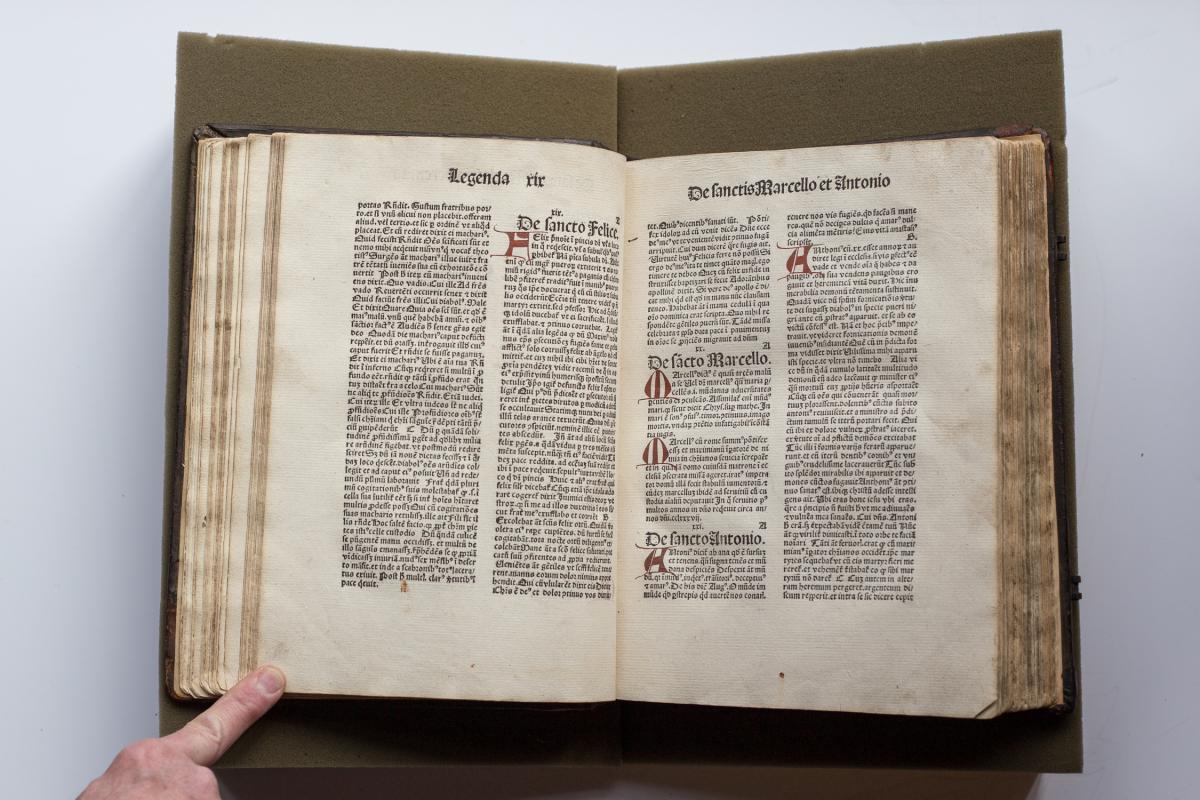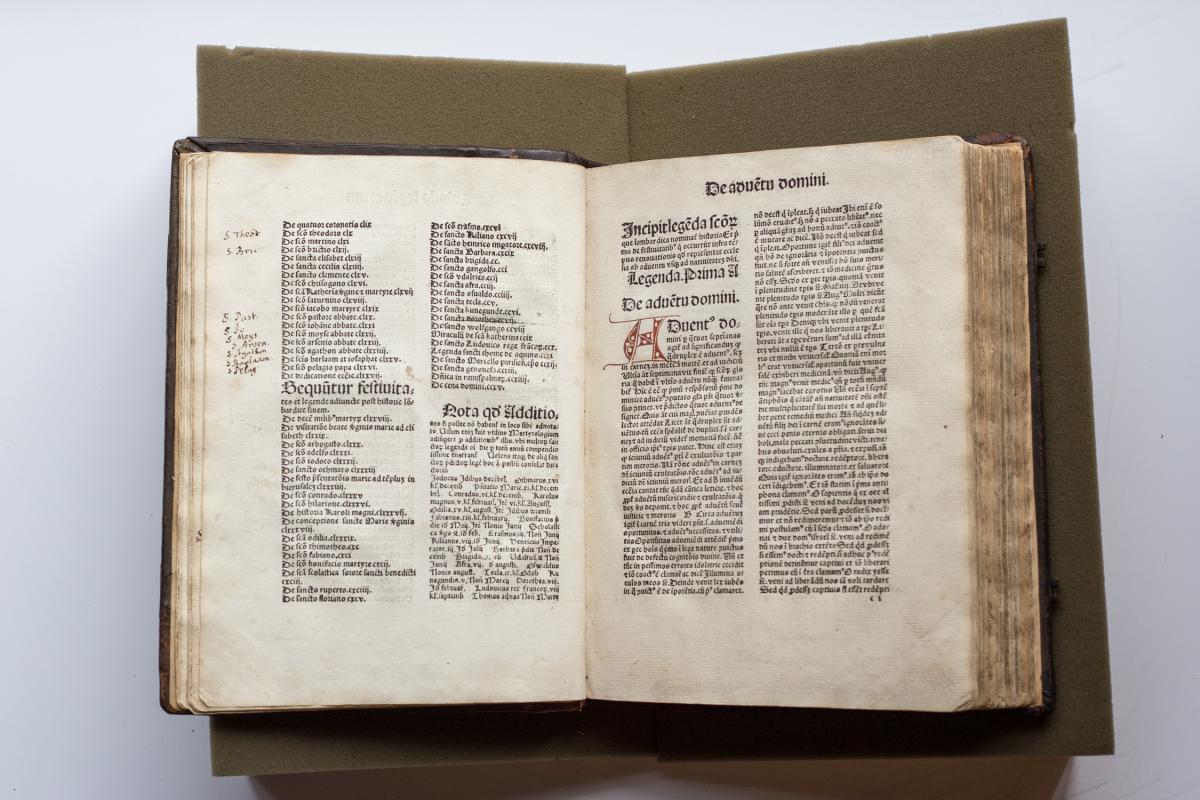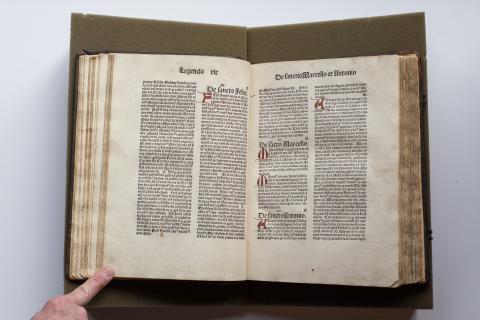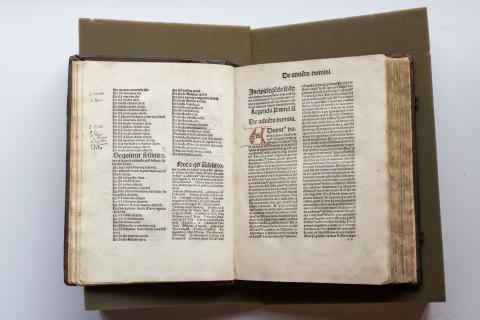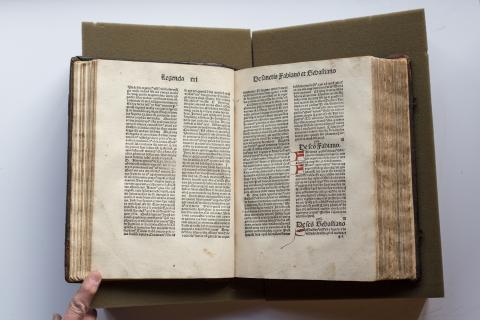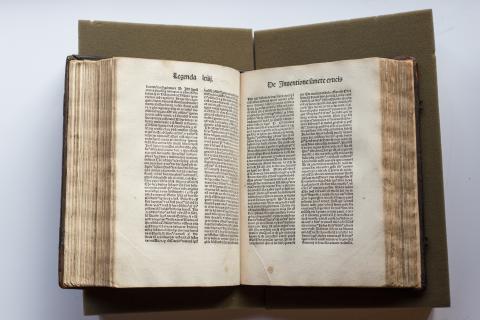Golden Legend | Legenda Aurea Sanctarum
Legenda Aurea Sanctarum|Golden Legend
German, 1470
Author: Jacobus de Voragine (Italian archbishop and chronicler, born 1228-1230, died 1298)
Rare first edition.
Multnomah County Library Catalog Info: 31168043978855
Josh Bobbitt, Medieval Portland Capstone Student, Summer 2005
The Legenda Aurea Sanctarum, originally titled Legenda Sanctarum, Latin for "Readings on the Saints," was one of the most widely read books of the Middle Ages, second only to the Bible itself. The interesting thing about the book was it gave people traditions of the lives of over two hundred saints and of Christ himself. This book was also translated widely, and, as soon as the printing press came upon the scene, the book was more popular than ever before. It was, indeed, one of the first books William Caxton printed in English, under the title of the Golden Legend.
This book was written by Jacobus de Voragine in c. 1260. He was a prominent preacher in his time and was made archbishop of Genoa in 1292. The Legenda became the predominant piece of hagiographical literature in Western Europe at that time. De Voragine usually prefaced chapters with fanciful etymologies of Saints' names. The stories of the lives of the Saints consist of acts of the Saints and of their relics. A typical Saint's life would be that of Saint Silvester getting spiritual guidance from Saint Peter the apostle, who enables him to exorcize a dragon. For the relics, we see stories similar to that of Saint Agatha, whose relics help repel an eruption from Mount Etna.
This book now in the Wilson Rare Book Room was previously cataloged as having notes written in it by Philip Melancthon. Melancthon was a professor of Greek at the University of Wittenberg, and was second only to Luther himself in the Protestant Reformation.
The copy of the Legenda in Wilson has two separate sales advertisements pasted inside the front cover. The catalog lists the description from one of the sales slips. This was the original book John Wilson planned on purchasing. The results, in Wilson's own writing, are that when payment was received in England, by the bookshop, the piece had already been sold. Wilson instead purchased a different copy of the Legenda from another bookshop for less than two pounds sterling.
This particular book is a very fine specimen of a late medieval codex. It is printed in Black Letter, or possibly Early Gothic Letter and the printing itself is uniform. The lettering is done in black, and the capitals are painted in red. The last one-fifth of the book's capitals are not completely red but have a metallic-bluish tint to them. After an exhaustive search, a likely theory has been found.
The mixing of the paint used by the Rubricator is suspected to be at fault. The gall used in the paint was not mixed properly, rendering it too acidic. This acidity caused the red pigment to fade in the places where the concentration of the ink is greatest. This explains why the color tends to be bluer, and more metallic in the thicker lines, as opposed to the flourishes. Over time, the acidic gall is known to eat through the pages of the document, though I have not come across any indication of it in this piece.
This book is bound together on four sets of double cords threaded into the wooden front and back pieces. The boards have been covered with leather binding, and both front and back have been embossed rather nicely. The embossing has faded over the years; however, it is still visible. The metal corner pieces have since been replaced with leather, as well as most of the spine of the book. There is also the remainder of clasp hinges on the covers of the book, though the actual clasps themselves are no longer present.
The repairs made on the volume were not all done very well, as the more recent leather does not match the original. The front and back faces of the book, as well as two panes on the spine, are the only original leather present on it. There are also some badly repaired, and obviously taped, pages in the book that leave something to be desired.
All in all, the book is a wonderful piece, which for all practical intents and purposes has been kept rather nicely. It is quite impressive, and despite its being over five hundred years old, is still rather sturdy. The fact the stories have stayed around for as long as they have, being translated quite a few times over the years, shows just how important this book is. While it may not be a true and historical account of the Saint's lives, it does show how people viewed the Saints in this period, and that in and of itself is of immense value.
Suggestions for further reading
- Brown, Michelle. Understanding Illuminated Manuscripts. Los Angeles: Getty, 1994.
- Ryan, William (trans.). The Golden Legend Volumes I & II. Princeton, NJ: Princeton University Press, 1995.
- Catholic Encyclopedia: Bl. Jacopo de Voragine (Di Viraggio). The Catholic Encyclopedia Vol VIII. Accessed 30 August 2005. http://www.newadvent.org/cathen/08262b.htm
- Medieval Sourcebook: The Golden Legend... Paul Halsall. Accessed 30 Aug 2005. http://www.fordham.edu/halsall/basis/goldenlegend/
- Voragine, Jacobus de (1230-1298). Christian Classics Ethereal Library. Calvin College. Accessed 30 Aug 2005.

